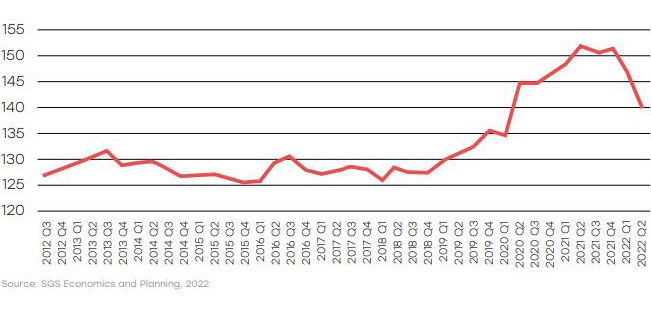Property mountains to climb after Andrews' election landslide
The Andrews Government's third term in office confronts myriad issues in the property and construction sectors, with housing affordability identified by voters as one of the main issues of the election campaign.
With Melbourne’s property market in remission, the rental market again tightening and public housing experiencing dire scarcity, the question facing the property market is whether the re-election of the Dan Andrews Labor government will mean more of the same or much needed policy progression.
From first-home buyers and investors, to renters and the 100,000 people on public housing waiting lists, there is a widely acknowledged need for an increase in housing supply.
Although falling now, since the last Victorian election in 2018, Melbourne’s house prices have soared 23.7 per cent higher, while unit prices are up 9.7 per cent. Regional house prices took off by 49.4 per cent amid an influx of tree-changers and fuelled by a dire housing supply shortage.
Surveys in major newspapers consistently ranked housing affordability as one of the election campaign priorities that would determine their vote.
Despite Liberal Party leader Matt Guy promising 150,000 new housing lots for Melbourne’s fringes over two years, and the removal of stamp duty for first-home buyers for one year, the public has rewarded Labor with around double the number of seats won by the opposition.
Labor’s signature housing policy when in government was the Big Housing Build in 2020, promising 10,000 renovated or new social and affordable homes by 2025.
They also extended a shared equity scheme. The government covers a maximum 25 per cent of the price of a property for buyers with a 5 per cent deposit, allowing them to purchase sooner.
Crisis worsening
Katelyn Butterss, Chief Executive Officer, Victorian Public Tenants Association, told API Magazine that cost of living pressures are only worsening the housing crisis in the state and that the Big Housing Build was not enough to solve the problem.
“More than 100,000 individual Victorians, including children, are covered by an application to the State’s joint public and community housing waitlist.
“As cost of living pressures show no sign of abating, it is likely this list will continue to grow.
“We’re looking for the next Parliament to deliver a pipeline of new publicly owned and managed homes – beyond the Big Housing Build – to ensure all Victorians have access to a safe, secure and affordable place to call home.
“We will continue to work with, and challenge, the Victorian Government to improve their service delivery to existing public housing renters, especially regarding maintenance, property modifications and upgrades,” Ms Butterss said.
Quentin Kilian, CEO, Real Estate Institute of Victoria, agreed more housing supply was needed, including public housing, as were policies to encourage more property investors.
“(Progress needs to be made) around the long-awaited findings of the consumer affairs Victoria property market review.
“Key priorities include overcoming the barriers into homeownership Victorians face, such as stamp duty, and shaping how government can work with the sector to address the mounting pressure on the rental market, and how to attract investors back into the market, as well as the next generation of the property workforce in Victoria,” Mr Kilian told API Magazine.
Tough times
Even though Greater Melbourne is the most affordable capital city in Australia for renters, they are still facing increasingly tough times.
Rents have risen across all dwelling types, particularly in the first two quarters of 2022.
According to SGS Economics and Planning’s Rental Affordability Index, released Wednesday (29 November), the average rental household in Greater Melbourne faces paying around 21 per cent of its total income on rent.
“During 2020 and 2021, affordability improved considerably in the inner city, inner north west, and in the north eastern suburbs,” the report noted.
“Since then, the easing of both local movement and international travel restrictions has begun to lower affordability in inner suburbs (within 5km of the CBD).”
Rental Affordability Index, Greater Melbourne*

*higher number denotes more affordable rental market.
The Andrews government was not overly active in addressing the issue in the lead-up to the election, revealing plans to cap rent increases to one per year in a tentative step aimed at resolving the housing affordability crisis.
It also announced stricter standards for rental housing, from lockable doors and openable windows to working heaters, and hot and cold water.
A spokesperson for the Strata Community Association (Victoria) told API Magazine they had engaged with the Labor Party and the Greens, who have won at least four seats, to ensure strata was better represented and considered in future strategy and decisions.

SCA said the two parties had responded to their policy priorities by agreeing to tackle a range of issues, including establishing a strata advice helpline, setting a minimum standard of education for Victorian owners corporation managers, supporting standardisation of electric vehicle (EV) charging infrastructure in new buildings and developments, and combatting the high prevalence of building defects in strata.
The beleaguered construction industry is somewhat buoyed by the Andrews government’s commitment to building 100 new schools and 50 government-owned and operated childcare centres.
The premier has also committed to building the Royal Melbourne and Royal Women’s Hospital Campus in the Arden Precinct.



















